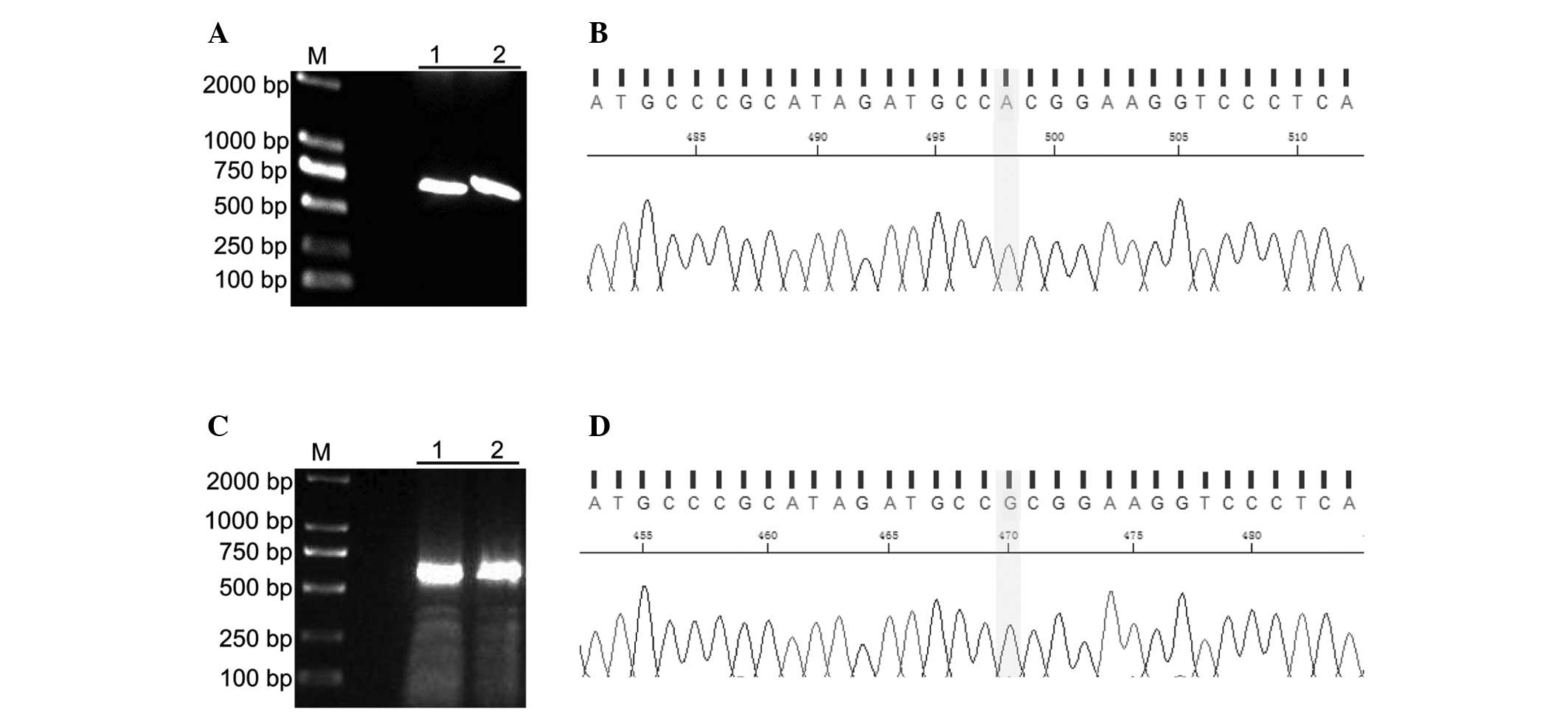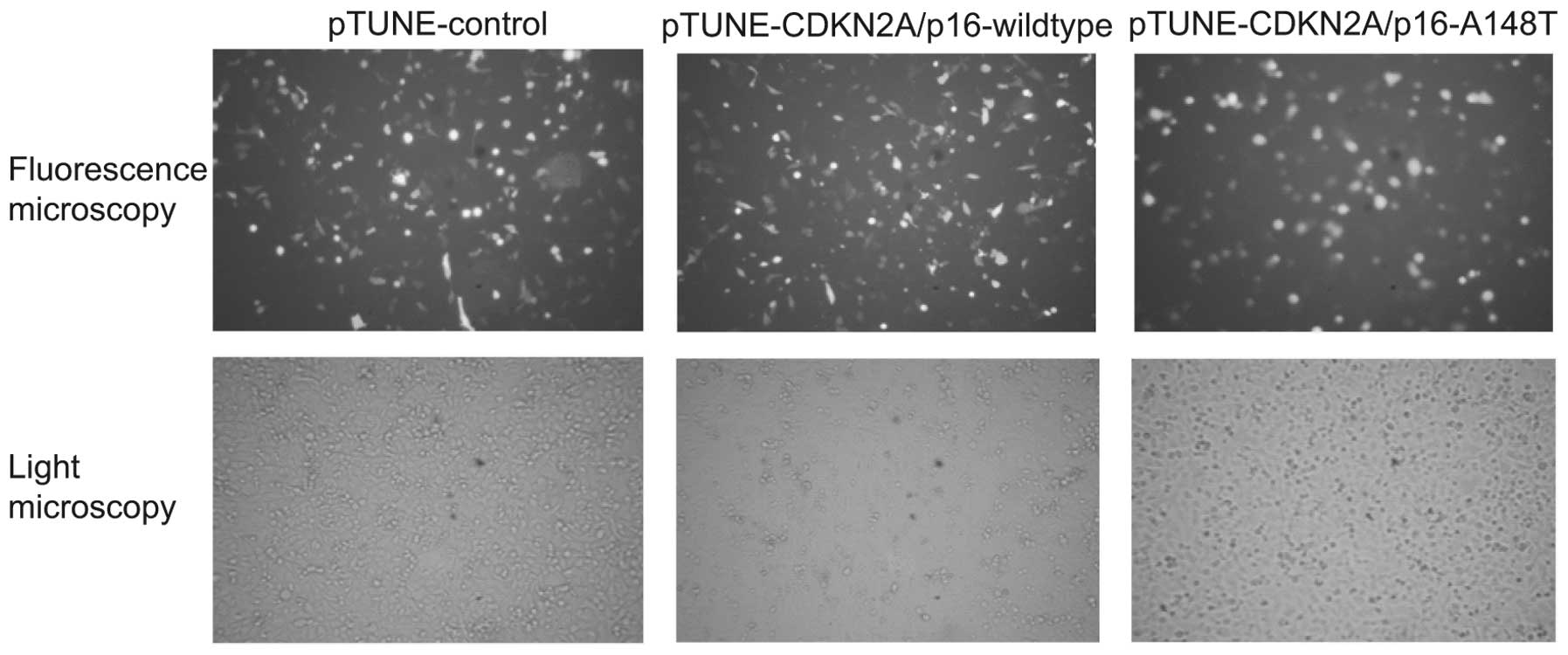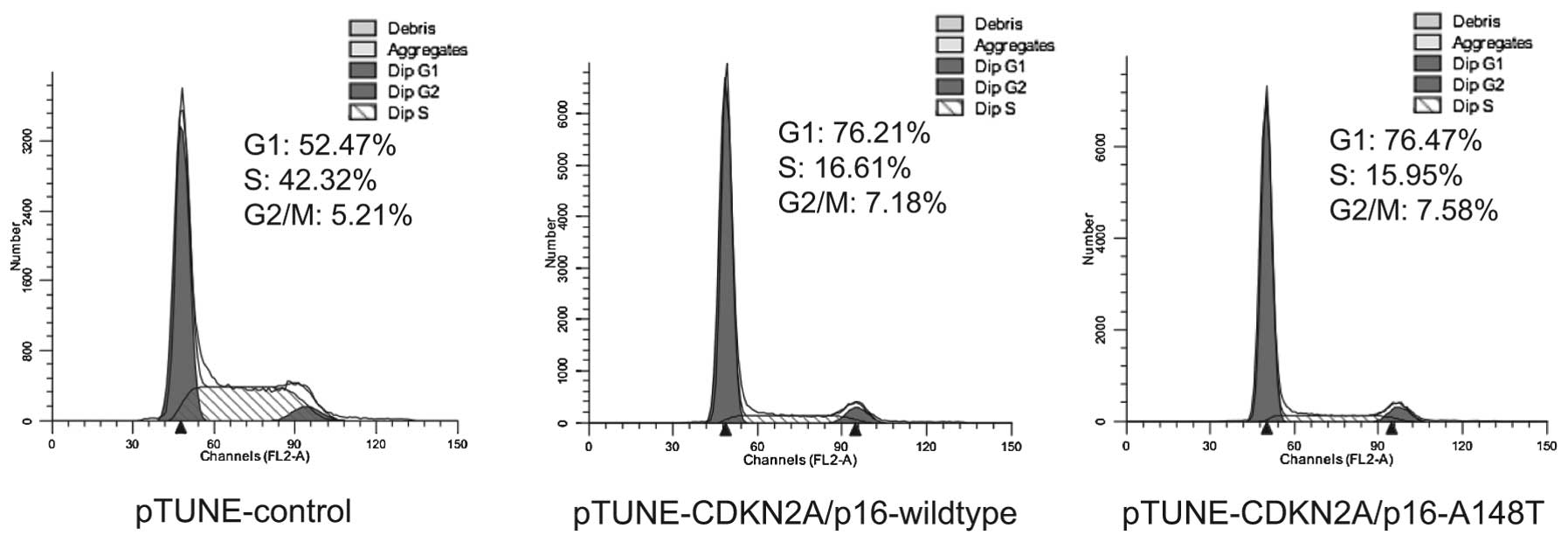Effect of tumor suppressor gene cyclin‑dependent kinase inhibitor 2A wild‑type and A148T mutant on the cell cycle of human ovarian cancer cells
- Authors:
- Published online on: February 11, 2014 https://doi.org/10.3892/ol.2014.1867
- Pages: 1229-1232
Abstract
Introduction
As a tumor suppressor gene regulating the cell cycle, cyclin-dependent kinase inhibitor 2A (CDKN2A/p16), is often found to be mutational in various types of human cancer (1). Loss of CDKN2A/p16 function arises by two main mechanisms: Homozygous deletion and 5′ CpG island hypermethylation with low transcription (2). Mutations in primary ovarian cancer and metastatic ovarian cancer do not occur at high frequency (3). However, the present study identified a single-base substitution from G to A in codon 148 of CDKN2A/p16 by sequencing human ovarian cancer cell line UACC-1598. The mutation results in the amino acid alanine (A) being substituted with threonine (T). It is known that the abnormal expression of cell cycle-regulating genes plays important roles in cancer cells (4), prompting the use of recombinant expression systems to investigate their function (5,6). The pTUNE vector establishes a gene expression system induced by isopropyl-β-D-thiogalactoside (IPTG) which utilizes repressor proteins and RNA interference to switch genes on or off while preserving gene function (7). Therefore, the present study used a pTUNE vector to construct human CDKN2A/p16-A148T mutant and CDKN2A/p16-wild-type gene expression systems in order to investigate the effect of CDKN2A/p16-A148T on the cell cycle.
Materials and methods
Cell culture and transfection
Human ovarian cancer cell line UACC-1598 was a gift from Dr Xin-Yuan Guan (University of Hong Kong, Hong Kong SAR, China). Human ovarian cancer cell line SKOV3 was purchased from American Type Culture Collection (Manassas, VA, USA). These cells were cultured in RPMI-1640 (Gibco, Carlsbad, CA, USA) containing 10% fetal bovine serum (PAA Laboraties GmbH, Pasching, Austria) at 37°C in a 5% CO2 humidified atmosphere.
Cells were seeded in six-well plates at a density of 5×106 cells/well, and the constructed expression vectors were transfected into cells using Lipofectamine 2000 (Invitrogen Life Technologies, Carlsbad, CA, USA).
Vector construction
The pTUNE inducible vector was obtained from OriGene Technologies Inc. (Rockville, MD, USA) as control vector. The primers specific for amplifying CDKN2A/p16 open reading frame (ORF) were synthesized by Invitrogen Life Technologies as follows: Primer 1 (hCDKN2A-SgfI), 5′-GAGGCGATGAGGCGATC GCATGGAGCCGGCGGCG-3′; primer 2 (hCDKN2A-XhoI), 5′-GCGCTCGAGATCGGGGATGTCTGAGGGACCTTC-3′; and primer 3 (hCDKN2A-XhoI), 5′-GCGCTCGAGAT CGGGGATGTCTGAGGGACCTTCCGCGGCATCTAG-3′.
The CDKN2A/p16-A148T ORF fragment was cloned from the cDNA template of UACC-1598 cells by polymerase chain reaction (PCR) with primers 1 and 2 specific to CDKN2A/p16. The PCR product was electrophoresed on a 2% agarose gel (Gene Tech Company Limited, Shanghai, China)and the predicted 490 bp fragment was extracted. The amplified ORF and the pTUNE inducible vector (OriGene Technologies, Inc.) were digested with endonuclease XhoI (New England Biolabs, Inc., Beijing, China) and SgfI (Promega Corporation, Madison, WI, USA). A ligation reaction was set up with linearized pTUNE vector and CDKN2A/p16 ORF using T4 DNA ligase (TransGen Biotech Co., Ltd., Beijing, China). The positive clone was picked up and the authenticity of the plasmid was confirmed by sequencing.
The CDKN2A/p16-wild-type ORF fragment was amplifed with primers 1 and 3 using the pTUNE-CDKN2A/p16-A148T vector template, which covers the mutation site and contains the wild-type base G substitution for correcting the sequence. The PCR product was separated by electrophoresis and the 490 bp fragment was extracted. The CDKN2A/p16-wild-type ORF was subsequently digested by the restriction enzymes XhoI and SgfI to construct the pTUNE-CDKN2A/p16-wild-type inducible vector. The positive clone was also sequenced for verification.
Flow cytometric analysis of the cell cycle
Cells were harvested by trypsinization and fixed with 70% ethanol at 4°C for 24 h. The cells were then centrifuged at 500 × g for 5 min, washed twice with phosphate-buffered saline and stained with buffers provided in the Cycletest™ Plus DNA Reagent kit (BD Biosciences, Franklin Lakes, NJ, USA) for analysis by flow cytometry.
Results
Verification of the transfection efficiency of pTUNE-CDKN2A/p16-wild-type and pTUNE-CDKN2A/p16-A148T mutant vectors
The present study identified a single-base substitution from G to A in codon 148 of CDKN2A/p16 by sequencing the human ovarian cancer cell line UACC-1598. This mutation resulted in the amino acid substitution of alanine (A) with threonine (T). pTUNE-CDKN2A/p16-A148T and pTUNE-CDKN2A/p16-wild-type expression vectors were successfully constructed (Figs. 1).
To verify the effect of the pTUNE-CDKN2A/p16-A148T and pTUNE-CDKN2A/p16-wild-type vectors, a CDKN2A homozygous deletion human ovarian cancer cell line, SKOV3, was selected (8). The constructed expression vectors pTUNE-CDKN2A/p16-A148T and pTUNE-CDKN2A/p16-wild-type were transfected into SKOV3 cells using Lipofectamine 2000 when the cells were ~80% confluent. After 24 h had elapsed, the cells were induced with 500 mM IPTG for an additional 36 h. As pTUNE-vectors contain green fluorescent protein (GFP) fragments, the efficiency of transfection was detected by fluorescence microscopy. The expression of wild-type and mutant CDKN2A/p16-GFP fusion protein increased markedly in the transfected SKOV3 cells following IPTG induction (Fig. 2). These results indicate that the vectors pTUNE-CDKN2A/p16-A148T and pTUNE-CDKN2A/p16-wild-type are effectively induced by IPTG and could be used for further study.
Influence of CDKN2A/p16-A148T on the cell cycle
CDKN2A/p16 is a cell cycle-regulating gene. In the present study, the effects of pTUNE-CDKN2A/p16-A148T and pTUNE-CDKN2A/p16-wild-type vectors on cell cycle regulation were examined. Cell cycle distribution of the transfected and IPTG-induced SKOV3 cells were determined by flow cytometry in three independent experiments. The results demonstrated that wild-type and A148T mutant expression of CDKN2A/p16 can induce cell cycle arrest in G1 phase (Fig. 3). This suggests that the amino acid substitution of A with T at codon 148 of CDKN2A/p16 does not influence the function of CDKN2A/p16 on cell cycle arrest.
Discussion
CDKN2A/p16 is an important factor in cell cycle regulation (9). As a tumor suppressor gene, the expression of CDKN2A/p16 is strictly controlled. When overexpressed, location-specific CDKN2A/p16 expression is lost and it appears in the cytoplasm and the nucleus. This exerts abnormal influence on cell growth and division, resulting in cellular senescence and apoptosis (10). In order to control CDKN2A/p16 gene expression, an inducible pTUNE vector system was selected. This system is designed for IPTG-inducible expression, compared with a standard system in which IPTG treatment would induce only modestly elevated expression of proteins. In the present study, SKOV3 cells transfected with pTUNE-CDKN2A/p16-wild-type and pTUNE-CDKN2A/p16-A148T plasmids demonstrated significant G1 arrest compared with control cells. This illustrates that the amino acid substitution of A with T at CDKN2A/p16 codon 148 does not interfere with its role in cell cycle regulation. Wolf et al have previously demonstrated G1 phase arrest when CDKN2A/p16 was overexpressed in SKOV3 cells, which caused inhibition of cell growth (11). It has been confirmed that the CDKN2A/p16-A148T mutant exists in several types of cancer, including ovarian cancer, and, with the exception of certain populations, it is associated with cancer risk (3,12–14). However, the CDKN2A/p16-A148T mutant in melanoma does not exhibit impaired CDK4 binding function (15). By sequencing human ovarian cancer cell line UACC-1598, the present study also identified the CDKN2A/p16-A148T mutant. Assessment of the effect of the CDKN2A mutant on the cell cycle yielded results consistent with previous studies in which the CDKN2A mutant did not decrease the inhibitory activity of cyclin D1/CDK4 (15,16).
In conclusion, this study identified CDKN2A/p16-A148T mutation in ovarian cancer cells. The inducible expression vectors of CDKN2A/p16-wild-type and CDKN2A/p16-A148T utilized in the study could be useful for further investigation into whether this somatic mutation can alter the tumor suppression functions of CDKN2A/p16.
Acknowledgements
This study was supported by the Program for Changjiang Scholars and Innovative Research Team in University (IRT1230); the New Century Support Program for the Excellent Scholar, Ministry of Education of China (NCET-10-0149, NCET-11-0954); and the National Natural Science Foundation of China (81272288).
References
|
Witkiewicz AK, Knudsen KE, Dicker AP and Knudsen ES: The meaning of p16(ink4a) expression in tumors: functional significance, clinical associations and future developments. Cell Cycle. 10:2497–2503. 2011. View Article : Google Scholar | |
|
Herman JG, Merlo A, Mao L, Lapidus RG, Issa JP, Davidson NE, Sidransky D and Baylin SB: Inactivation of the CDKN2/p16/MTS1 gene is frequently associated with aberrant DNA methylation in all common human cancers. Cancer Res. 55:4525–4530. 1995.PubMed/NCBI | |
|
Schuyer M, van Staveren IL, Klijn JG, vd Burg ME, Stoter G, Henzen-Logmans SC, Foekens JA and Berns EM: Sporadic CDKN2 (MTS1/p16ink4) gene alterations in human ovarian tumours. Br J Cancer. 74:1069–1073. 1996. View Article : Google Scholar : PubMed/NCBI | |
|
Rayess H, Wang MB and Srivatsan ES: Cellular senescence and tumor suppressor gene p16. Int J Cancer. 130:1715–1725. 2012. View Article : Google Scholar : PubMed/NCBI | |
|
Outwin E, Carpenter G, Bi W, Withers MA, Lupski JR and O’Driscoll M: Increased RPA1 gene dosage affects genomic stability potentially contributing to 17p13.3 duplication syndrome. PLoS Genet. 7:e10022472011. View Article : Google Scholar : PubMed/NCBI | |
|
Walker F, Zhang HH, Odorizzi A and Burgess AW: LGR5 is a negative regulator of tumourigenicity, antagonizes Wnt signalling and regulates cell adhesion in colorectal cancer cell lines. PLoS One. 6:e227332011. View Article : Google Scholar : PubMed/NCBI | |
|
Deans TL, Cantor CR and Collins JJ: A tunable genetic switch based on RNAi and repressor proteins for regulating gene expression in mammalian cells. Cell. 130:363–372. 2007. View Article : Google Scholar : PubMed/NCBI | |
|
Schultz DC, Vanderveer L, Buetow KH, Boente MP, Ozols RF, Hamilton TC and Godwin AK: Characterization of chromosome 9 in human ovarian neoplasia identifies frequent genetic imbalance on 9q and rare alterations involving 9p, including CDKN2. Cancer Res. 55:2150–2157. 1995. | |
|
Zhang W, Zeng Z, Zhou Y, Xiong W, Fan S, Xiao L, Huang D, Li Z, Li D, Wu M, Li X, Shen S, Wang R, Cao L, Tang K and Li G: Identification of aberrant cell cycle regulation in Epstein-Barr virus-associated nasopharyngeal carcinoma by cDNA microarray and gene set enrichment analysis. Acta Biochim Biophys Sin (Shanghai). 41:414–428. 2009. View Article : Google Scholar | |
|
Romagosa C, Simonetti S, López-Vicente L, Mazo A, Lleonart ME, Castellvi J and Ramon y Cajal S: p16(Ink4a) overexpression in cancer: a tumor suppressor gene associated with senescence and high-grade tumors. Oncogene. 30:2087–2097. 2011. View Article : Google Scholar : PubMed/NCBI | |
|
Wolf JK, Kim TE, Fightmaster D, Bodurka D, Gershenson DM, Mills G and Wharton JT: Growth suppression of human ovarian cancer cell lines by the introduction of a p16 gene via a recombinant adenovirus. Gynecol Oncol. 73:27–34. 1999. View Article : Google Scholar : PubMed/NCBI | |
|
Nagore E, Montoro A, García-Casado Z, Botella-Estrada R, Insa A, Lluch A, López-Guerrero JA and Guillén C: Germline mutations in CDKN2A are infrequent in female patients with melanoma and breast cancer. Melanoma Res. 19:211–214. 2009. View Article : Google Scholar : PubMed/NCBI | |
|
Bakos RM, Besch R, Zoratto GG, Godinho JM, Mazzotti NG, Ruzicka T, Bakos L, Santos SE, Ashton-Prolla P, Berking C and Giugliani R: The CDKN2A p.A148T variant is associated with cutaneous melanoma in Southern Brazil. Exp Dermatol. 20:890–893. 2011. View Article : Google Scholar : PubMed/NCBI | |
|
Spica T, Portela M, Gérard B, Formicone F, Descamps V, Crickx B, Ollivaud L, Archimbaud A, Dupin N, Wolkenstein P, Vitoux D, Lebbe C, Saiag P, Basset-Seguin N, Fargnoli MC, Grandchamp B, Peris K and Soufir N: The A148T variant of the CDKN2A gene is not associated with melanoma risk in the French and Italian populations. J Invest Dermatol. 126:1657–1660. 2006. View Article : Google Scholar : PubMed/NCBI | |
|
Ranade K, Hussussian CJ, Sikorski RS, Varmus HE, Goldstein AM, Tucker MA, Serrano M, Hannon GJ, Beach D and Dracopoli NC: Mutations associated with familial melanoma impair p16INK4 function. Nat Genet. 10:114–116. 1995. View Article : Google Scholar : PubMed/NCBI | |
|
Lilischkis R, Sarcevic B, Kennedy C, Warlters A and Sutherland RL: Cancer-associated mis-sense and deletion mutations impair p16INK4 CDK inhibitory activity. Int J Cancer. 66:249–254. 1996. View Article : Google Scholar |












